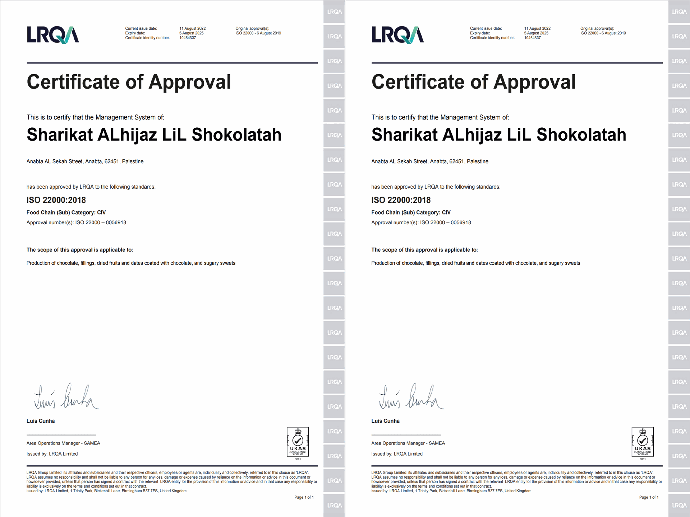ISO 22000 FSSC
مواصفة الأيزو 22000:
صادرة عن المنظمة الدولية للمعايير International Standard Organization (ISO)، يتم بموجبها إنشاء نظام للمراقبة يشمل تطوير إجراءات وقائية أو تصحيحية للوقاية من مخاطر التلوث الغذائي لضمان أن جميع أصناف الشوكولاتة آمنة للاستهلاك من لحظة إنتاجها حتى تصل إلى المستهلك. فهي بذلك تعزز ثقة المستهلك في جودة منتجاتنا.
تتضمن المواصفة تحديد وتقييم والوقاية من مخاطر محتملة قد تؤثر على سلامة الغذاء:
1.مخاطر بيولوجية: تشمل البكتيريا، والفيروسات، والطفيليات، والفطريات.
2.مخاطر كيميائية: تشمل الملوثات مثل السموم الطبيعية كالأفلاتوكسين، والمضافات غير المصرح بها.
3.مخاطر فيزيائية: تشمل أي مادة غير مقصودة في الغذاء وتسبب ضرراً مثل البلاستيك، والحجارة، والمعادن.
إنَّ مواصفة الأيزو 22000، تشمل عدة عناصر:
1.نظام إدارة سلامة الأغذية Food Safety Management System (FSMS): وضع سياسة وأهداف جودة وسلامة الأغذية وتحديد كيفية تحقيقها لقياس مدى التزام المنظمة.
2.تحليل المخاطر وضبط نقاط التحكم الحرجة Hazard Analysis and Critical Control Points (HACCP): كمنهجية للتحديد والتحكم أو القضاء على الخطر. مثال، تحديد الخطر: تلوث المنتج بسبب العاملين، نقطة اللتحكم الحرجة (CCP): من خلال تعليمات السلامة الغذائية وتوفير تدريب للعاملين على النظافة الشخصية أثناء العمل. إجراءات الرقابة: مراقبة الالتزام اليومية من قبل مراقب الجودة والسلامة الغذائية. الضبط الدوري من خلال إجراء مسحات مخبرية للتأكد من خلو بيئة العمل والأسطح من الملوثات. الإجراءات التصحيحية: في حال التحديد المبكر للتلوث، اتخاذ خطوات لإزالة المصدر وتعزيز التدريب والإشراف. التوثيق والتسجيل: تسجيل جميع الإجراءات والنتائج المتعلقة بتدريب العاملين، المراقبة اليومية، و الاختبارات المخبرية. التحقق و المراجعة: مراجعة دورية لفعالية الإجراءات المتخذة وتحديثها إذا لزم الأمر. هذا النهج يساعد في ضمان تحديد ومنع مخاطر التلوث في بيئة إنتاج الأغذية، مما يعزز سلامة المنتج النهائي.
3.برامج ضبط أساسية لدعم بيئة عمل آمنة Pre-request programs (PPRs): تتعلق بالنظافة، وتدريب الموظفين، وصيانة المرافق والمعدات والآلات، إدارة الموردين، مكافحة الآفات، إدارة النفايات، إجراء الاستعداد لحالات الطوارئ، وآلية التتبع، والتحكم في درجة الحرارة والرطوبة.
4.التحقق من استمرارية فعالية النظام والتحسين المستمر: من خلال جمع وتنظيم وتحليل بيانات التحقق من سجل حالات عدم المطابقة "لجولات ممارسات تصنيعية جيدة" Good Manufacturing Practices (GMP)، والتدقيق الداخلي والخارجي، وتوثيق وتسجيل الإجراءات والسياسات والاحتفاظ بالسجلات التي تثبت فعالية النظام.

FSSC 22000: بينما يوفر معيار ISO 22000 إطاراً شاملاً لإدارة سلامة الغذاء، يضيف معيار FSSC 22000 متطلبات إضافية وبرامج شروط أساسية (PRPs) أكثر تحديداً، بالإضافة إلى الاعتراف الدولي من قبل مبادرة سلامة الغذاء العالمية GFSI. هذه الإضافات تعزز من موثوقية نظام إدارة سلامة الغذاء وتساعد الشركات على تحقيق قبول أوسع في الأسواق الدولية.
1.متطلبات إضافية محددة: متطلبات إضافية محددة ل :FSSC 22000 تتضمن هذه المتطلبات عناصر إضافية للتحكم في الأمن الغذائي، إدارة المواد المسببة للحساسية، إدارة الإشعارات وسحب المنتجات، و إدارة الموارد البشرية.
2.تعزيز البرامج الأساسية: بينما يتطلب ISO 22000 برامج الشروط الأساسية (PRPs)، فإنَّ FSSC 22000 يحدد متطلبات أخرى أو أكثر تحديداً تتعلق بجوانب مثل النظافة، التحكم في الآفات، صيانة المعدات، ،إدارة المخلفات.
و يتوافق معيار FSSC 22000 مع معايير إدارة أخرى مثل ISO 9001 (إدارة الجودة) و ISO 14001 (إدارة البيئة)، مما يسهل على الشركة تنفيذ أنظمة إدارة أخرى.